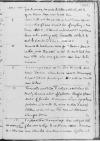List #5769
Alfonso de VALDÉS do Ioannes DANTISCUS[Regensburg], [ca. 1532-04-16 ?]
Regest polski: Valdes nie odpisał wcześniej, ponieważ był bardzo zajęty, a przy tym nie miał dla Dantyszka żadnych wiadomości. Wyrzuca mu brak cierpliwości i podejrzliwość. Tłumaczy, że załatwianie jego spraw przedłuża się z powodu choroby cesarza, który nawet własne sprawy zmuszony był zaniedbać. Zapewnia o swojej życzliwości. Podoba mu się portret (simulacrum), prześle więc drugi, aby Dantyszek kazał go poprawić na podobieństwo pierwszego. Przekazuje prośbę pana Granvelli, aby Dantyszek przysłał mu malarza nazajutrz o piątej rano.
Rękopiśmienne podstawy źródłowe:
Pomocnicze podstawy źródłowe:
Publikacje:
| ||||||||||||||||
Tekst + aparat krytyczny + komentarzZwykły tekstTekst + komentarzTekst + aparat krytyczny
Salutem.
cf.
Simulacrum placet et aliud ad te mittam, ut ad eum modum corrigi facias.[1] Dominus
Vale.
Tuus
[1] Simulacrum mentioned here could be a medal, as they were produced in many copies, which were cast in metal and then often manually reworked by the medallist. In 1529-1532 both Dantiscus and Valdés were portrayed by a German medallist and sculptor
